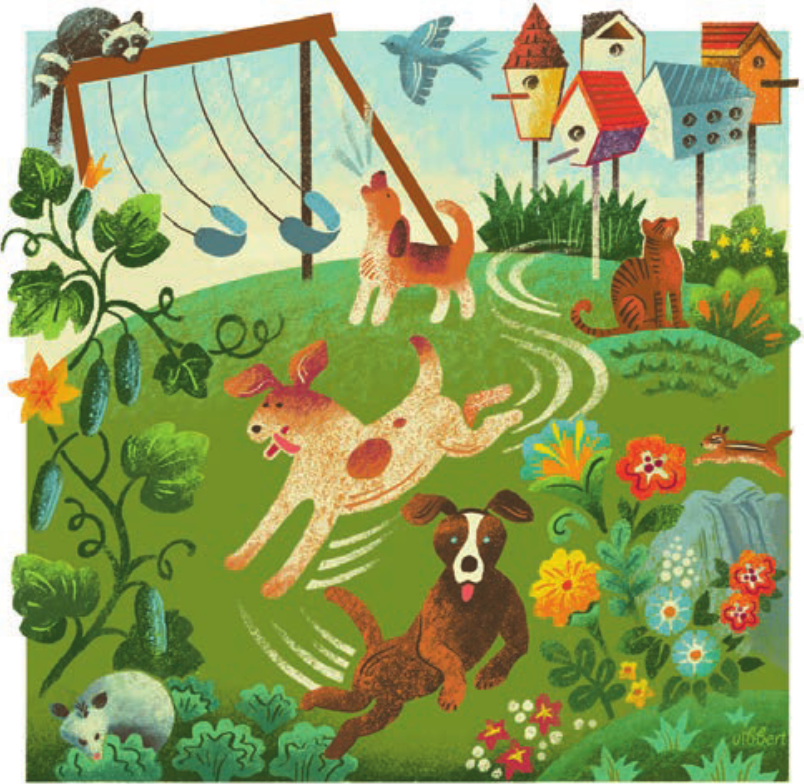A Living Backyard
Creating a microenvironment to call your own.
Our family is engaged in a pitched battle with the microenvironment otherwise known as our backyard.
We don’t want to fight our garden.
Or the squirrels. Or the birds. We wish only that our small, quiet lot behind our city home sustains the pleasant utopian calm it once had— a place for respite, where my daughter could casually pick cucumbers off the vine and where every day brought a new flower color popping into the open.
But it’s not to be. Not yet, anyway.
This spring, we plan to redouble our efforts to re-create the environment we once had. We’re working on it, but for now, it’s best to turn the current situation into a lesson.
Where to begin? Let’s start with a gust of wind. Some time in the middle of last year, a rogue gust of wind knocked over a center post of one of the high wooden fences that gave our yard a sense of privacy. With one post gone, the rest of the side fence collapsed—all nine panels—opening our yard to the sightlines of our next-door neighbor.
I should say, our next-door neighbors and their three dogs. This was, apparently, an all-new world for those dogs: a whole universe of people and plants and swingsets hitherto unnoticed; an all-new world to bark at. All three of them. All the time.
This barking scared our cat, Lavendar. Once the protector of our backyard, scaring off chipmunks and squirrels and racoons (oh my!), the barking dogs caused Lavendar to move her prowlings over to the neighbor’s house on the other side of us—a neighbor who considers herself a birder with a backyard full of dozens of homemade birdhouses.
Now without a guard, the urban animals came to feast in our yard, while the birds—due to our cat—left our neighbor’s yard and headed even farther up the street, disrupting the quiet lot of a neighbor two doors down from us.
The dogs barked. The cat left our yard. The birds left our neighbor’s welcoming yard and menaced another yard. Our garden was picked through by squirrels unafraid of dogs.
A whole city block’s environment turned upside down because of a fence.

It was none other than Kierkegaard who believed the only thing standing between humans and harmony with our natural environment was man himself. I’m unsure if he had backyards in mind when taking about the natural environment, but I’ll bet he didn’t have to deal with a possum eating his lettuce either.
One fellow I know understands our dilemma is our own Robert Frost. Never have I truly understood, until now, how much fences make for better neighbors.
My daughter doesn’t seem to mind, of course. To her, all this commotion just means more animals and bugs, and she sees this as a positive.
“Dogs bark, Daddy,” she points out. “Bugs have to eat.” This logic is, of course, irrefutable. Still, this spring, we’ll come at the “problem” again and try to restore balance in our little corner of the neighborhood. But fencing isn’t cheap and supply issues remain. We did roll out a short, cloth fence cover over the chain link that now separates our yards, and that seems to have mollified the dogs somewhat. Lavendar is still suspicious, and who can blame her?
Little Bean’s bedroom faces the backyard, and the other evening, we saw the motion detector light click on. So, we watched for a while from her window as a small racoon snooped around—a learning experience to be sure, brought about because of a wind gust.
All in all, the experience has provided a window into what, exactly, a sustainable environment is. What even constitutes a natural environment? Can we ever actually control an environment, even if that environment is our own backyard? We would certainly like to think so. But maybe the wind and the trees and the earth have other ideas. The possums, too. And the dogs.
Adaptation may ultimately be the key. My daughter seems to think so.
She has taken to talking to the barking dogs, trying to “Beauty and the Beast” them into submission. My wife will plant a garden less attractive to the backyard critters. Maybe Lavendar will come back.
Maybe the birds will make our next-door neighbors happy again.
Or maybe the wind always blows and it all changes and it all stays the same. And we are part of that as well. Us, and our fence, and the dogs. We sustain.
BY DAN SZCZESNY | ILLUSTRATION BY CAROLYN VIBBERT